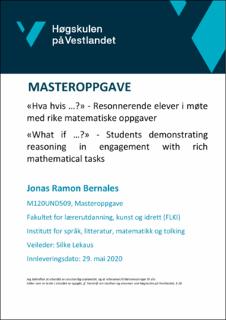| dc.description.abstract | In this master’s thesis I have researched 7th grade students in Norway demonstrating reasoning in engagement with rich mathematical tasks, which conditions the students set to the tasks and how these conditions affected their mathematical reasoning. The study is based on Hagland’s, Hedrén’s and Taflin’s (2005) definition on rich mathematical tasks. Among other things, these tasks are detected by introducing mathematical ideas, being easy to work with, stimulate to mathematical conversation based on different solutions and can lead students and teachers to generate new interesting mathematical problems. These traits may lead students to demonstrate reasoning and ask questions to the task that may become conditions.
The theoretical framework about reasoning is based on a mix from Baroody’s (1993), Hana’s (2013), Lithner’s (2006; 2008) and Reid’s (2002) definitions about different forms of reasoning. These definitions have been used to elucidate some of the students’ reasoning, mainly deductive reasoning. In addition, Balacheff’s (1988) study about aspects of proof in pupils’ practice has been used to suggest some possible explanations for the results from this thesis.
The theoretical framework about looking at the conditions set by the students is inspired by Silver’s (1993) and Stoyanova’s and Ellerton’s (1996) definitions about problem posing. The main point is that a student, based on their mathematical experience, constructs personal interpretations of situations, and formulates meaningful mathematical problems. This is linked together with what Stylianides (2016) calls “proving tasks with ambiguous conditions”. These types of tasks are intentionally ambiguous – and thus subject to different legitimate assumptions by students – with a purpose to lead students to ask questions. These questions, which may become conditions, can affect the mathematical content that students work with – and this can affect the mathematical reasoning in some way.
The results show that 7th grade students often use deductive reasoning linked to arithmetic rules. There were also cases where students reasoned with assumed premises to reach a conclusion, which means they used hypothetically deductive reasoning. I have also seen one example of a creative mathematically founded reasoning, which was generated by a couple of students who spent time, effort and thought activity while working on a task.
Furthermore, I saw that the students – when facing rich mathematical tasks – not only set conditions that affected the mathematical content, but also spent time suggesting how to include conditions that seemed derogatory from the mathematical content. I see that the teacher’s input in such cases is a key variable to put students back on a mathematical track. | en_US |

